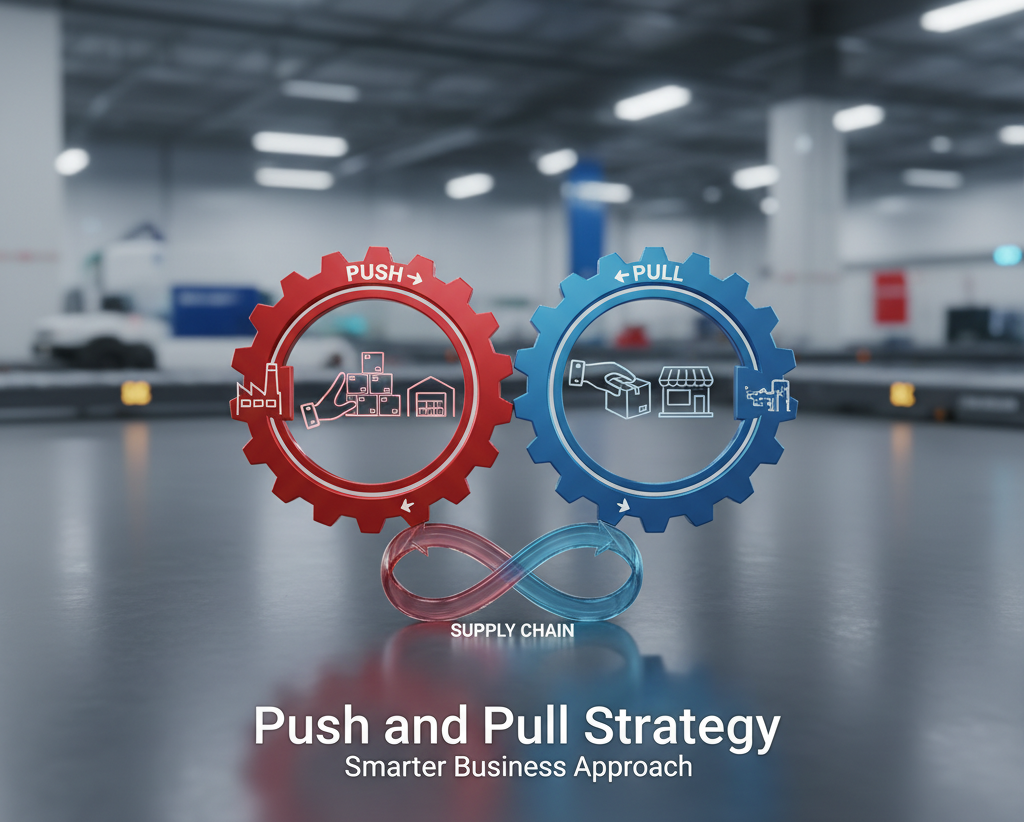In today’s fast-moving world of e-commerce and global trade, companies are under constant pressure to deliver products faster, reduce costs, and keep customers happy. At the heart of this challenge lies the supply chain—and how businesses manage it can make or break success. One powerful approach that companies often rely on is the push and pull strategy in supply chain management.
But what does this really mean? And how can startups, e-commerce brands, and traditional businesses apply it effectively? Let’s break it down in a simple, human way.
What is the Push Strategy?
Imagine you’re baking cookies at home. You make 100 cookies in advance, expecting guests to arrive. You “push” the supply before actual demand comes in.
That’s what a push strategy in supply chain means:
- Products are manufactured in advance.
- Businesses rely on forecasts, market trends, or historical data.
- Inventory is stocked before customer orders come in.
Benefits:
- Economies of scale (bulk production lowers cost).
- Quick availability of goods for customers.
- Works well for products with stable demand (e.g., toothpaste, soaps, packaged food).
Drawbacks:
- Risk of overproduction.
- Storage costs go up.
- Unsold goods may lead to losses.
What is the Pull Strategy?
Now think about a pizza shop. They don’t bake pizzas before customers arrive. Instead, they prepare a fresh pizza after you place an order. That’s pull strategy in action.
Here’s how it works in supply chains:
- Products are made after receiving real customer demand.
- Businesses rely less on forecasting, more on actual orders.
- Inventory is lean, reducing storage costs.
Benefits:
- Lower inventory waste.
- Customized products for customers.
Efficient for unpredictable or luxury items (e.g., custom furniture, high-end fashion).
Drawbacks:
- Slower delivery time compared to push.
- May struggle with sudden spikes in demand.
Push vs. Pull: Which One Wins?
The truth is—neither strategy alone is perfect. That’s why modern supply chains use a hybrid push-pull approach.
Think of IKEA:
- They use push for mass production of furniture parts, which are stocked in warehouses.
- But they use pull at the store level, where customers assemble or customize based on their needs.
Or consider Zara (fashion giant):
- They “pull” by quickly designing based on trending customer preferences.
- They “push” by stocking fast-fashion clothing in limited batches to create urgency.
- This mix ensures flexibility, cost savings, and better customer satisfaction.
How Businesses Can Apply Push and Pull Strategy
Whether you’re a startup, SME, or an established retailer, here’s how you can leverage this strategy:
1.Know Your Product Category
- For predictable demand items → use push.
- For uncertain demand items → use pull.
2. Use Data Smartly
Advanced analytics, AI, and demand forecasting tools can help balance between push and pull.
3. Build Agile Supply Chains
Partner with suppliers and logistics firms who can quickly adapt to demand changes.
4. Customer-Centric Approach
Today’s customers expect personalization. Combining push for basic needs and pull for premium/custom items can build brand loyalty.
Conclusion
The push and pull strategy in supply chain is more than a theoretical concept—it’s the backbone of efficient global trade. While push brings cost efficiency and preparedness, pull delivers flexibility and customer satisfaction. The smartest businesses combine both approaches, ensuring they stay competitive, agile, and profitable in an unpredictable market.
FAQs
1. Which industries benefit most from push strategy?
Industries like FMCG (fast-moving consumer goods), pharmaceuticals, and packaged foods benefit most because demand is stable and predictable.
2. Is pull strategy only for luxury products?
Not at all. Pull strategy works for any product with unpredictable demand—whether it’s custom T-shirts, on-demand electronics, or even fresh food services.
3. What’s the biggest risk of relying only on push?
The biggest risk is overstocking, which leads to higher storage costs and possible product waste.
4. Can small businesses apply a hybrid approach?
Yes! Even small businesses can push standard products in bulk but use pull for customized or limited-edition items.
5. How do technology tools help in push-pull strategy?
AI, machine learning, and supply chain software help forecast demand, track inventory, and adapt quickly—making the balance between push and pull much easier.
